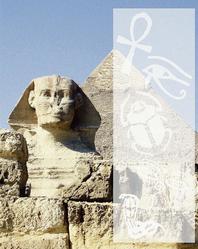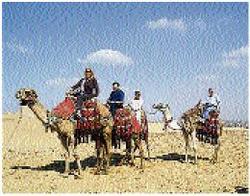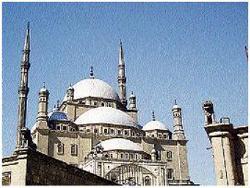Laura Tanna, Contributor

Khafre Pyramid guarded by the Sphinx or 'Father of Terror' at Giza.
Forty-five years ago I visited Cairo for the first time. My father was great friends with a fellow Rhodes Scholar from Egypt. We stayed in their family home, after first registering with the police as foreigners had to do in 1963 under Nasser's regime.
Cairo remains the one place in the world that exceeded my expectations, as exotic, mysterious and alluring as one's imagination. The pyramids weren't smooth. They were big stepping blocks on which one could climb and to enter, there was a ramp, a dank, earthen tunnel down into the inner chamber. Our guide blew out the candle, leaving us in darkness. We joke now that our host gave him more bakseesh to guide us out again. I was sore for a week from the camel ride and the tram back into town past all the street life as the evening turned purple-velvet remains with me forever. Tutankhamun's sarcophagus we saw up close as the curator at the museum was a friend. Our hostess drove; even then traffic was such that she waved one fist out the window and said things in Arabic it was probably better we didn't understand. The ceramic tiles on the Blue Mosque were exquisite but not the unbearable 104-degree heat in May.
Now, February 1, we're in Giza, a Cairo suburb, where the Great Pyramid of Khufu or Cheops, over 4,600 years old, rises against a cloudless blue sky, three smaller queens' pyramids to the side. No longer can one climb to the top. That was banned in 1980. Entering the second pyramid, one queues, even early in the morning. There are metal steps and a railing now going down, down into a dark entrance. People exit, complaining of the heat inside. It wasn't like this before. There's nowhere to turn if you get stuck inside in the crowd. Suddenly, I panic. Giving in to claustrophobia, I clamber back up the steps to outside, much to the relief of my friends behind, who say they were only going in to please me!
Congestion is a blessing
The Sphinx, lion's body and Pharaoh's headdress, 20 metres tall, guards the pyramid of Khafre, the only one with the original smooth limestone covering left on top. Camels are still there so we ride for an hour into the desert to view the pyramids and Cairo in the distance, four times passing dead horses, the last being gnawed by fat dogs - shades of hyenas after lions kill a zebra. We spend the night nearby in the historic Mena House Hotel, the pyramids visible from their café, restaurant and some rooms. Run by the Oberoi Group, they've expertly arranged our airport pick-up and Giza tour.
In Cairo, we stay at the Four Seasons Nile Plaza on Corniche el Nil, within walking distance of the Egyptian Museum. We're surprised by the hotel's helpful travel tips: "Be aware of pickpockets at tourist sites, but it's quite safe to walk in the streets, even late at night." How many cities can say that? It's Friday, Moslem holy day. Traffic is light but we appeal to the tourist police to help us cross streets. There are almost no stop lights in all of Cairo so cars just keep moving. People walk through traffic, but not me. The policeman looks for us on our return and helps us again. Congestion is a blessing; at least then, one crosses more easily. At the museum we stand in the wrong line. There are separate queues for local and foreign tickets. Inside the relics from ancient Egyptian tombs are tremendous stacks and stacks of sarcophagi for countless mummies, spectacular gold and lapis lazuli jewellery - too much to tell you but two hours there and we are surfeited with knowledge of ancient Egyptian religion and history. Outside, a vendor tends to his gorgeous fat cats. Ancient Egyptians once worshiped cats and still treat animals (except perhaps horses) with great respect and affection. I love it!
The hotel's excellent concierge arranges a personal guide, air-conditioned van with driver and works with us to plan an itinerary for Saturday. Hala, our female guide, is an Egyptologist whose English is excellent and her company enjoyable. We visit Old Cairo first, an area arising inside a third century AD Roman fort. After the decline of ancient Egyptian religion, before the rise of Islam in the seventh century AD, Alexandria became the world's centre for Jews after they were forced from Jerusalem in first century AD.
We visit Ben Ezra Synagogue, Egypt's oldest. Then the Church of St Sergius where Joseph, Mary and Jesus are believed to have sheltered in a cave on that spot during the Holy Family's travels throughout Egypt fleeing King Herod's persecution. The Church of St George, named for a Roman legionary martyred in the third century AD for becoming Christian, and the Hanging Church, perched on timbers over two Roman towers, are reminders of what early Christians endured. In every centre of worship - Egyptian, Jewish, Christian or Moslem - I wear slacks or long skirts, sleeves and a head scarf out of respect for local customs.
Mamluk architecture
The superb Coptic Museum, with its wealth of material presented in a modern manner, reminds us why the Government is moving the 1902 Egyptian Museum collection to a new, larger building in Giza by 2011. The excellent Cairo Metro stops by the Coptic Museum, but with our driver we head north to the Blue Mosque, stopping first at the Old Cairo Bazaar, a neighbourhood store with extraordinary inlaid mother of pearl boxes, furniture, silver and gold jewellery, ceramic plates-we're tempted but wait for the famous Khan al Khalili market at day's end.
The Blue Mosque, deserted, undergoing restoration with only one section of exquisite blue tiles left makes me glad I saw it before. At the Mosque of Sultan Hassan, an example of Mamluk architecture, it's noon and while Hala prays I remember learning the Mamluks were slaves brought in as palace servants and soldiers, many from Eastern Europe - Serbia, Hungary, etc. - who grew so powerful they ruled Egypt from 13th century AD and much of the Middle East until defeated by Ottoman Turks in 1516 AD. Finally we reach the nearby Citadel founded in 1176 by Saladin, but it is Mohammed Ali, who ruled 1805-1849, creating the foundation of modern Egypt, who left the most impressive monument, a Turkish-designed mosque whose silver domes are spectacular, as are the mosque's interior pulpits. French King Louis-Philippe's gift of an ornate clock in the court yard has never worked, whereas Mohammed Ali's gift of an obelisk from the Temple of Luxor is now a Paris landmark!
Shopping
Khan al Khalili market's narrow lanes of shops where one bargains for all manner of goods, especially silver, brass and clothing, entertains us for an hour. "I went to school with you." "I am your brother." The vendors are charming and know when to leave one alone. We end this perfect introduction to Cairo with a meal in the market, at Naguib Mahfouz Café named for the Nobel Prize-winning Egyptian author and run by the Oberoi Group. Reservations are recommended because the Egyptian food is delicious, especially the koshari, and the place so popular!
Alone on our last day we take a taxi (they are inexpensive) to Mahmoud Khalil Museum. A wealthy politician in the 1930s/40s left this beautiful mansion filled with priceless ceramics and French Impressionist paintings to the State. President Sadat used it as his official residence. Now the public enjoys it. Our taxi waits, then we visit the Gezira Arts Centre with its beautiful ceramic collection. I think of Cecil Baugh, remembering his days in Egypt and his Egyptian blue. We pop into adjoining modern art galleries and are bowled over by the excellence of Egyptian artists, ancient and modern.
At night, across the Nile from the Corniche, the view reminds us of Hong Kong's brilliant neon-lit skyline. Who knew Cairo has such different neighbourhoods, such incredibly rich history? We must return.

Handbags in Khan al-Khalili.

Riding camels in the desert.

The Mohammed Ali Mosque in the Citadel. - Contributed Photos

